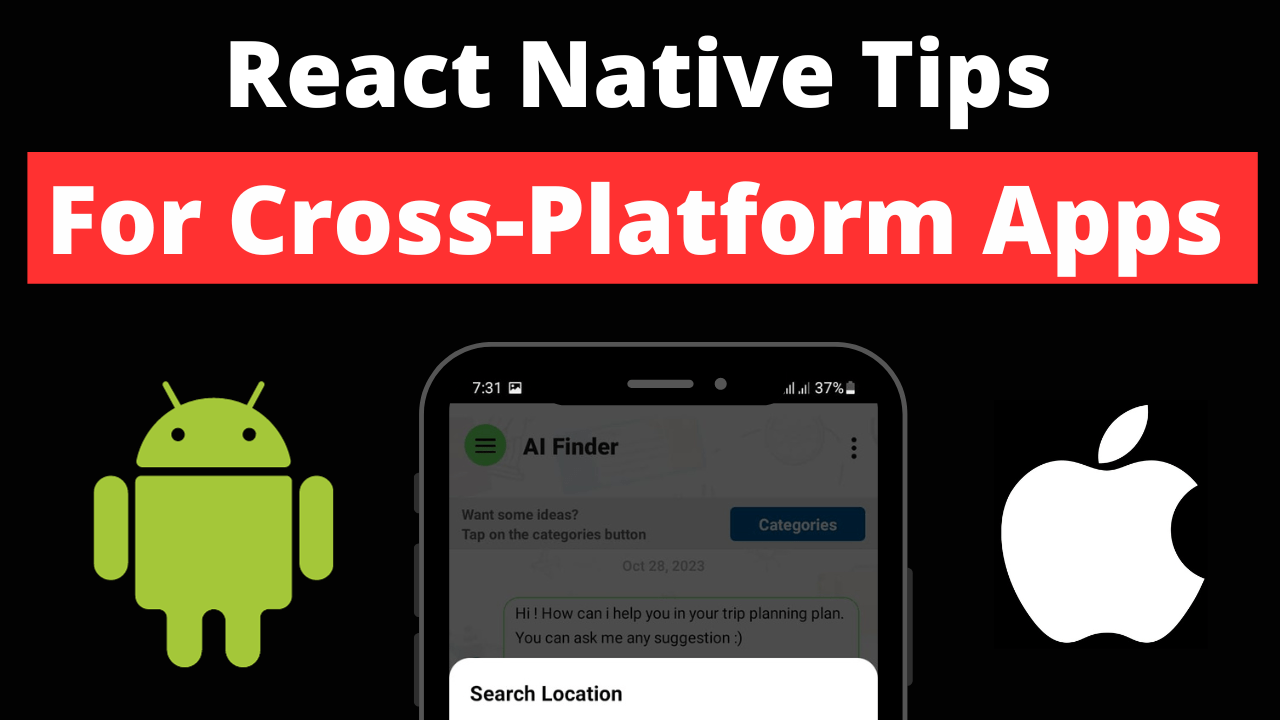When building cross-platform apps with React Native, it’s important to focus on practices that leverage the framework’s strengths while addressing common challenges in cross-platform development. Here are some detailed tips and best practices:
1.Begin with a Solid Foundation:
Before diving into coding, ensure that you have a clear understanding of React Native’s fundamentals. Familiarize yourself with its core components and principles, as this knowledge is crucial for effective development.
2.Optimize Code Reusability:
Take advantage of React Native’s ability to share code between iOS and Android. Aim for maximum code reuse but be mindful of platform-specific differences. Sometimes, creating separate components for each platform can be more efficient than trying to force a one-size-fits-all solution.
3.Navigation and Screen Transitions:
Utilize libraries like React Navigation for implementing navigation patterns in your app. Proper navigation setup is key to a seamless user experience, especially when dealing with multiple screens and data passing between them.
4.State Management and Data Flow:
Effective state management is critical. Use React’s built-in hooks or external libraries like Redux or MobX for managing global state. This ensures a consistent and predictable state throughout your application, which is especially important in complex apps.
5.Utilize React Native’s Components Effectively:
Familiarize yourself with React Native’s core UI components for developing intuitive interfaces. Components such as Text, View, and Image are essential for building basic yet powerful user interfaces.
6.Responsive and Adaptive UI Design:
Employ the Flexbox layout system for responsive designs. Tailor your UI to adapt to various screen sizes and orientations, ensuring a consistent user experience across different devices.
7.Handling Platform-Specific Code:
When dealing with platform-specific features, use React Native’s platform module to write platform-specific code. This approach helps in maintaining a clean and organized codebase.
8.Performance Optimization:
Focus on performance aspects like optimizing image loading, efficient rendering, and minimizing bundle size. React Native offers several tools and techniques for performance tuning. For a deep dive into how you can enhance your app’s performance, consider reading the detailed article on React Native Performance Optimization
9.Debugging and Testing:
Utilize React Native’s debugging tools, such as React Native Debugger and Chrome Developer Tools, to inspect and debug components, states, and props. Regular testing with frameworks like Jest and Detox is essential for ensuring app reliability and functionality.
10.Asynchronous Programming:
Understand and effectively implement asynchronous programming in React Native. This is crucial for tasks like data fetching, file uploads, or any operations that require waiting for a response. Use JavaScript features like async/await and promises for cleaner and more manageable code.
11.Local Storage and Data Management:
Make use of AsyncStorage for storing local data. This is key for saving user preferences, caching, and managing offline data. For more complex data management, consider integrating a local database like Realm or SQLite
12.Utilize Device Features and APIs:
React Native’s architecture allows for easy access to device features and APIs. This includes utilizing device sensors like the camera, GPS, and accelerometer. By bridging JavaScript and native modules, you can implement device-specific functionalities, enhancing your app’s capabilities and user experience
13.Continuous Integration and Delivery (CI/CD):
Implement CI/CD pipelines to automate the testing and deployment process. This practice not only saves time but also ensures that your app maintains a high standard of quality with each update. Automation in testing and deployment can significantly reduce human error and streamline the release process.
14.Leverage Third-Party Libraries:
The React Native ecosystem is rich with third-party libraries that can save time and effort. Before reinventing the wheel, check if there is a library available that meets your needs. However, be cautious and evaluate each library’s performance, maintenance status, and community support before integrating it into your project.
15.Adopt an Agile Development Methodology:
React Native aligns well with agile development practices. Use iterative development, continuous feedback, and flexible planning to adapt to changes quickly. This approach allows you to build a more user-centered application and respond to market changes effectively.
16.Focus on User Experience (UX):
Ensure that the app delivers a high-quality UX. This includes smooth navigation, fast load times, and an intuitive interface. Pay attention to detail in design and functionality to ensure that the app is not only functional but also enjoyable to use.
17.Regular Updates and Maintenance:
Keep your app up-to-date with the latest React Native versions and dependencies. Regular updates are crucial for security, performance improvements, and accessing new features. Also, address user feedback and bug reports promptly to maintain a positive user experience.
18.Community Engagement and Support:
Engage with the React Native community. Platforms like GitHub, Stack Overflow, and React Native forums are invaluable resources for getting support, learning best practices, and keeping up with the latest trends and updates in the React Native ecosystem.
19.Documentation and Code Quality:
Maintain high standards of code quality and documentation. Well-documented code is easier to understand, maintain, and scale. It also helps new team members to get up to speed quickly.
20.Consider Accessibility and Internationalization:
Make your app accessible to a wider audience by considering accessibility features and internationalization. This includes support for multiple languages, right-to-left text support, and accessibility features for users with disabilities.
Conclusion:
By following these tips and best practices, you can effectively leverage React Native’s capabilities for building robust, efficient, and user-friendly cross-platform mobile applications. This approach to app development not only streamlines the process but also ensures a high-quality product that stands out in the competitive mobile app market.

